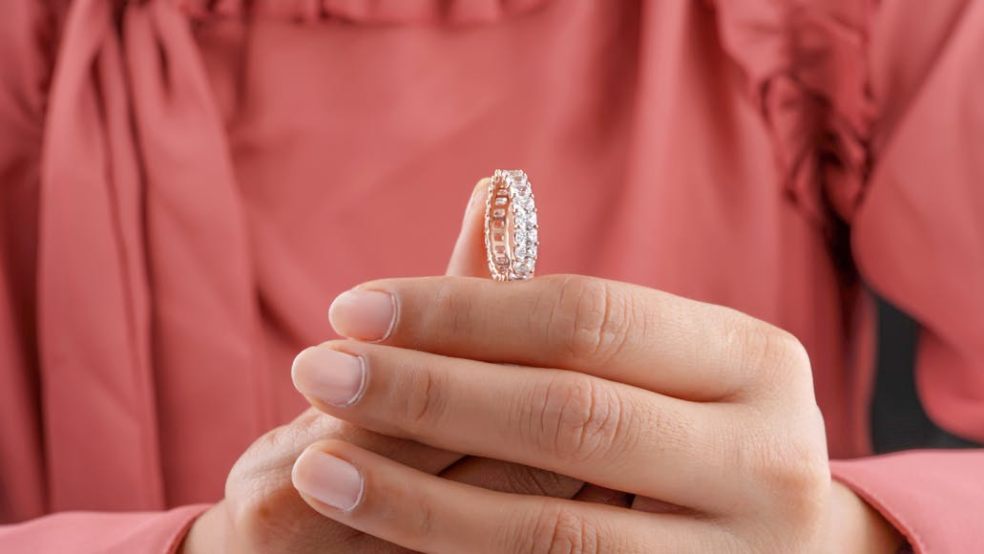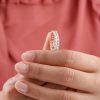
Everything you Need to Know about Lab-Grown Diamond Bands
Even though lab-grown diamonds have been on the market since the 1980s, they have recently seen a significant rise in popularity. These modern stones, produced in laboratories instead of being extracted from the earth, have changed how jewelers and buyers view diamonds.
So what’s the hype about? A new way of producing what used to be a precious stone has made purchasing diamonds easier for budget-minded couples seeking a cheaper—and possibly more sustainable and ethical—option compared to mined diamonds.
Although there are more lab-created diamonds available than ever, the subject is still enveloped in mystery. If you're looking to purchase one of these fashionable diamonds, you may be curious about their creation, their appeal, and what distinguishes them from natural diamonds. Continue reading for all the essential information regarding lab-created and natural diamonds.
Are lab-created diamonds real?
Yes, diamonds produced in laboratories are real diamonds. Diamonds created in labs are chemically, visually, and physically the same as mined diamonds. So what causes the uncertainty regarding the authenticity of lab-created diamonds? Many people instinctively think that a diamond produced in a lab is a counterfeit diamond, yet no actual difference exists. Lab-created diamonds consist of the identical carbon and DNA found in mined diamonds.
They are as sturdy and brilliant as diamonds extracted from the ground. However Lab-grown diamond bands must not be mistaken for diamond substitutes such as moissanite, white sapphire, or cubic zirconia, which replicate the appearance of a colorless gem, yet are entirely chemically distinct from both lab-grown and natural diamonds.
Lab-Grown vs. Natural Diamonds
As we've noted, even though they are artificially created stones, lab-grown diamonds (occasionally misleadingly called "synthetic diamonds") are authentic. Although scientists create them, lab-grown diamond bands consist of the same pure, crystallized carbon found in natural diamonds, share the same capability to refract light in various colors (meaning they exhibit that stunning sparkle), are highly durable, and are available in the same forms and dimensions.
In reality, lab-grown and natural diamonds are the sole materials on Earth that possess a Mohs 10 hardness; the top hardness rating, designated solely for diamonds.
Lab-grown diamonds and natural diamonds vary in several aspects: Lab-grown diamonds are produced in a laboratory instead of being extracted from the ground. Certain natural diamonds might have small levels of nitrogen, whereas lab-created diamonds do not.
One more significant distinction between lab-created and naturally sourced diamonds? The price. Although the specific cost of a lab-grown diamond band varies based on the quality and size of the selected stone, they are typically more affordable than mined diamonds. Because lab-created diamond bands have a reduced resale value and require significantly less time and labor to produce, experts suggest that lab-grown diamonds may be priced between 20% and 50% lower than natural diamonds.
How are lab-grown diamonds made?
There are two methods to produce a lab-created diamond: The initial method is Chemical Vapor Deposition (CVD). A small "seed" diamond is subjected to intense heat within a securely sealed chamber.
The chamber is subsequently filled with a gas mixture rich in carbon, initiating several chemical reactions that allow pure carbon to attach to the diamond seed. Ultimately, you obtain a genuine diamond, achieved through a process taking a few months rather than a million years.
The alternate technique is High Temperature, High Pressure (HTHP), utilizing massive presses that may weigh several tons to create extraordinarily high pressure and temperature, transforming a diamond "seed" into a completely developed, lab-created diamond. The HTHP method varies, yet it similarly simulates the earth's natural process of creating mineral diamonds.
After creation, jewelers shape and refine lab-grown diamonds in the same manner as they do with natural diamonds. Similar to mined diamonds, this process yields a rough stone that requires expert craftsmanship and imaging to determine the best ways to cut the unrefined diamond into various shapes.
One major advantage of these two techniques: Whereas natural diamonds may require roughly 3.3 billion years to develop and subsequently need to be mined from deep underground, a lab-created diamond can be produced in just two weeks.
How are lab-grown diamonds certified and graded?
Commonly known as diamond grading, diamond certification is a process that assesses a diamond's quality according to the 4Cs—carat, color, clarity, and cut. Purchasing a certified diamond is crucial for understanding precisely what you're investing in and for comparing your diamond's price with those of similarly graded stones.
Lab-created diamonds are evaluated and certified by the same independent grading organizations (GIA, IGI, HRD) that assess natural diamonds. Every lab-created diamond possesses a distinct fingerprint, and only a small number are of gem quality, similar to mined diamonds. Even fewer are those that are colorless (DEF grade) and lack macroscopic inclusions (IF-VVS clarity). Lab-created diamonds possess the same varieties of certifications as those that are mined.
IGI was the first gemological institute to recognize and assess lab-grown diamonds, beginning in 2005. IGI's lab-created diamond certificates vary from those for natural diamonds in several aspects, notably by specifying the method of growth utilized. To ensure clear differentiation for consumers, they use a distinct colored report cover and consistently engrave 'lab-grown' on the girdle of the stone using a laser.
Benefits of buying lab-grown diamond bands
Lab-grown diamond bands have undeniably changed the conventional diamond market for three main reasons: Their reduced price allows for more sparkle for your money, they are less harmful to the environment and need less labor to create compared to natural diamonds.
The production of lab-created diamonds requires significantly less water, energy, carbon emissions, land, and disruption of earth's minerals compared to mined diamonds, and it also addresses ethical labor issues associated with mining operations.
Although it's uncommon for natural diamonds to be conflict diamonds (often referred to as blood diamonds) today, buying a lab-created diamond ensures 100% assurance that your gem was obtained ethically. Lab-created diamond bands offer a significant opportunity for diamond buyers and investors to experience the luxury of diamonds sustainably, considering both human and environmental aspects.

















